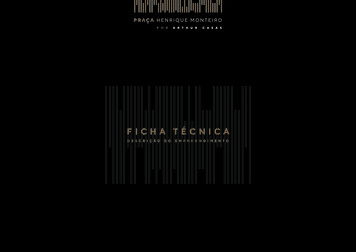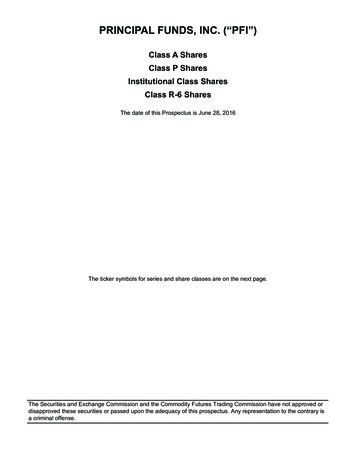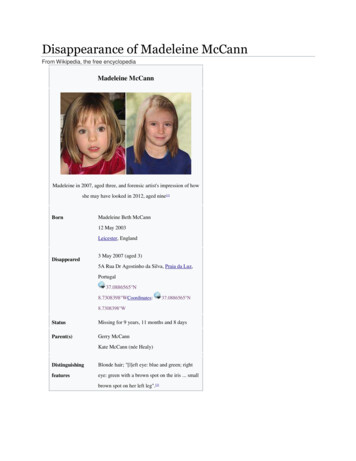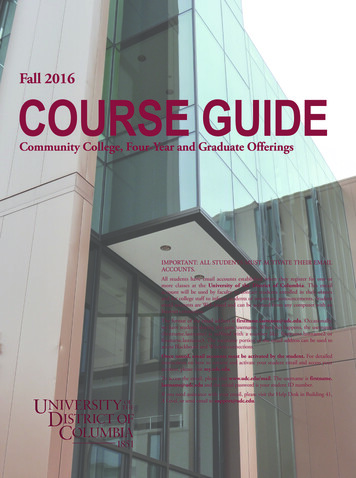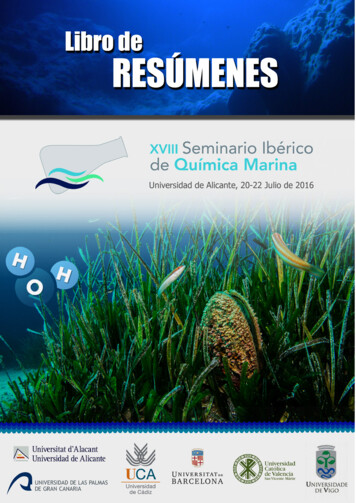
Transcription
(2016)XVIII Seminario Ibérico de Química MarinaAlicante (España), 20-22 Julio 20162
(2016)Esta publicación debe citarse como:VALLE C, AGUILAR J, ARECHAVALA P, ASENSIO L, BLASCO J, CABRERA R, COBELO A, CORBÍ H, CRAVO A, DELA-OSSA JA, DEL-PILAR Y, FERNÁNDEZ V, FERNÁNDEZ Y, FERRERO LM, FORCADA A, FORJA J, GIMÉNEZ F,GÓMEZ A, GONZÁLEZ JM, IZQUIERDO D, LEÓN V, MARCO C, MARTÍNEZ E, ORTEGA T, RAMOS A, RUBIO E,SÁNCHEZ JL, SÁNCHEZ P, SANTANA M, SANZ C, TOLEDO K, ZUBCOFF JJ (Ed.). 2016. Libro de Resúmenes. XVIIISeminario Ibérico de Química Marina. Universidad de Alicante, Alicante. 114 pp. ISBN: 978-84-16724-18-5.Edita:Universidad de AlicanteDepartamento de Ciencias del Mar y Biología AplicadaISBN:978-84-16724-18-5Diseño de portada:Imagén de portada:Maquetación:Luis M. FerreroPablo ArechavalaLuis M. Ferrero, Pablo Arechavala, Reme CabreraEsta obra está bajo una Licencia Creative Commons Atribución-NoComercial 4.0 Internacional3
(2016)Comité organizadorAbelardo Gómez, Universidad de CádizAlexandra Cravo, Universidade do AlgarveAntonio Cobelo, Instituto de Investigaciones Marinas, CSICJesús Forja, Universidad de CádizJulián Blasco, Instituto de Ciencias Marinas de Andalucía, CSICMagdalena Santana Casiano, Universidad Las Palmas de Gran CanariaRocío Ponce, Universidad de CádizTeodora Ortega, Universidad de CádizVictor León, Instituto Español de OceanografíaComité organizador localAitor Forcada, Universidad de AlicanteAlfonso Ramos, Universidad de AlicanteCandela Marco, Universidad de AlicanteCarlos Sanz, Universidad de AlicanteCarlos Valle, Universidad de AlicanteDavid Izquierdo, Universidad de AlicanteElena Martínez, Universidad de AlicanteEsther Rubio, Universidad de AlicanteFrancisca Giménez, Universidad de AlicanteHugo Corbí, Universidad de AlicanteJavier Aguilar, Universidad de AlicanteJosé Antonio de la Ossa, Universidad de AlicanteJosé Jacobo Zubcoff, Universidad de AlicanteJosé Luis Sánchez, Universidad de AlicanteJosé Miguel González, Universidad de AlicanteKilian Toledo, Universidad de AlicanteLeticia Asensio, Universidad de AlicanteLuis M. Ferrero, Universidad de AlicantePablo Arechavala, Universidad de Alicante4
(2016)Pablo Sánchez, Universidad de AlicanteReme Cabrera, Universidad de CádizVictoria Fernández, Universidad de AlicanteYoana Del Pilar, Universidad de AlicanteYolanda Fernández, Universidad de AlicanteComité científicoXosé Anton Álvarez Salgado, Instituto de Investigaciones Marinas, CSICAbelardo Gómez Parra, Universidad de CádizAntonio Tovar, Instituto de Ciencias Marinas de Andalucía, CSICFiz F. Pérez, Instituto de Investigaciones Marinas, CSICGuillermo Grindlay, Universidad de AlicanteIsidro M. Pastor, Universidad de AlicanteJosep M. Gasol, Institut de Ciències del Mar, CSICLuís Lubián, Instituto de Ciencias Marinas de Andalucía, CSICMaría J. Bebianno, Universidade do AlgarveMelchor González Dávila, Universidad Las Palmas de Gran CanariaMiguel Caetano, Instituto de Investigacao das Pescas e do MarRicardo Prego, Instituto de Investigaciones Marinas, CSIC5
(2016)Instituciones organizadoras:Universidad de AlicanteUniversitat de BarcelonaUniversidad de CadizUniversidad Católica de Valencia San Vicente MártirUniversidad de Las Palmas de Gran CanariaUniversidad de Vigo6
(2016)AUTOR / Área temática / Tipo de comunicación . # PáginaÁLVAREZ-IGLESIAS et al. / Contaminación y ecotoxicología marinas / Póster . 9ÁLVAREZ-VÁZQUEZ et al. / Contaminación y ecotoxicología marinas / Póster . 12ÁLVAREZ-VÁZQUEZ et al. / Procesos biogeoquímicos / Oral . 14APARICIO-GONZÁLEZ et al. / Cambio climático / Poster . 17BAENA-NOGUERAS et al. / Contaminación y ecotoxicología marinas / Oral . 19BASALLOTE et al. / Contaminación y ecotoxicología marinas / Oral . 21BASALLOTE et al. / Contaminación y ecotoxicología marinas / Póster . 23BEBIANNO et al. / Conferencia invitada . 25BIEL-MAESO et al. / Contaminación y ecotoxicología marinas / Oral. 26BRITO et al. / Procesos biogeoquímicos / Póster . 28COBELO-GARCÍA et al. / Contaminación y ecotoxicología marinas / Oral . 30CORREIA et al. / Oceanografía / Póster . 32COZAR / Conferencia invitada . 35DÍAZ et al. / Contaminación y ecotoxicología marinas / Póster . 38DURÁ et al. / Procesos biogeoquímicos / Póster. 40GARCÍA-GUERRA et al. / Contaminación y ecotoxicología marinas / Oral . 42GÓMEZ-PARRA et al. / Procesos biogeoquímicos / Oral . 44GONZALEZ et al. / Procesos biogeoquímicos / Oral. 46GONZÁLEZ-GARCÍA et al. / Oceanografía / Oral . 48GONZÁLEZ-ORTEGÓN et al. / Procesos biogeoquímicos / Póster. 50GUERRA et al. / Procesos biogeoquímicos / Póster. 52JEREZ-MARTEL et al. / Procesos biogeoquímicos / Oral . 54JIMÉNEZ-LÓPEZ et al. / Cambio climático / Oral . 56JIMÉNEZ-LÓPEZ et al. / Cambio climático / Oral . 58LEÓN et al. / Contaminación y ecotoxicología marinas / Oral . 60LÓPEZ-SÁNCHEZ et al. / Oceanografía / Póster . 63MARTÍNEZ-PÉREZ et al. / Oceanografía / Oral . 65MIL-HOMENS et al. / Contaminación y ecotoxicología marinas / Póster. 67MORENO-ANDRÉS et al. / Contaminación y ecotoxicología marinas / Oral . 70MUÑOZ-LECHUGA et al. / Procesos biogeoquímicos / Póster . 73ORTEGA et al. / Cambio climático / Oral . 75ORTEGA et al. / Procesos biogeoquímicos / Póster . 77PÉREZ-ALMEIDA et al. / Oceanografía / Oral . 79PINARDI et al. / Conferencia invitada . 81PINTADO-HERRERA et al. / Contaminación y ecotoxicología marinas / Oral . 82RAIMUNDO et al. / Contaminación y ecotoxicología marinas / Oral. 84RIBEIRO et al. / Contaminación y ecotoxicología marinas / Póster . 867
(2016)RODRÍGUEZ-ROMERO et al. / Cambio climático / Póster . 89ROSA et al. / Oceanografía / Oral . 91SAMPER et al. / Contaminación y ecotoxicología marinas / Póster. 93SÁNCHEZ-QUILES et al. / Contaminación y ecotoxicología marinas / Oral . 94SANTANA-CASIANO / Contaminación y ecotoxicología marinas / Oral . 96SENDRA et al. / Contaminación y ecotoxicología marinas / Oral . 99SIERRA et al. / Cambio climático / Oral. 102TOVAR-SÁNCHEZ et al. / Contaminación y ecotoxicología marinas / Póster . 105TOVAR-SÁNCHEZ et al. / Contaminación y ecotoxicología marinas / Póster . 107TRAVERSO-SOTO et al. / Contaminación y ecotoxicología marinas / Póster. 109TROMBINI et al. / Conferencia invitada . 1118
(2016)Timing of lead sources and bioavailability in sediments from San SimónBay (NW Spain): core scanners as complementary toolsPaula Álvarez-Iglesias1,2, Isabel Rodríguez-Germade1, Belén Rubio1, Daniel Rey1, BegoñaQuintana3 & Jorge Millos21Grupo GEOMA, Dpto. de Geociencias Marinas y Ordenación del Territorio, Facultad de Ciencias, Universidade de Vigo,Vigo 36310 Spain2Servicio de Seguridad Alimentaria y Desarrollo Sostenible, C.A.C.T.I., Universidade de Vigo, Vigo 36310 Spain3Laboratorio de Radiaciones Ionizantes, Dpto. de Física Fundamental, Universidad de Salamanca, Salamanca, 37008 SpainABSTRACTSan Simón Bay (inner Ría de Vigo), a well-known Pb polluted area, was selected for monitoring the historicalPb pollution and its diagenetic evolution based on pore water and sediment analyses on two sediment corescollected close to the main Pb input, a ceramic factory. The age-model was constructed by Pb-210 dating andcorroborated by the detection of temporal markers in different cores (Cs-137, Pb maxima inputs). Very high Pbtotal contents were observed, more than half in the recoverable fraction. Pb stable isotope ratios confirmed theceramic factory as the main Pb input, even after its closure. Results obtained by conventional and high-resolutionXRF techniques (Itrax core scanner) were combined to monitor Pb pollution. The Itrax core scanner provideddetailed information on core sediment composition, which could affect radionuclide activities, and metalvariability.INTRODUCTIONCoastal sedimentary environments are very sensitive toanthropogenic activities and have been the target ofnumerous pollution studies [1]. In particular, very high Pblevels were detected in San Simón Bay (inner Ría de Vigo,NW Spain), being the main source an ancient ceramicfactory located at the NE coast of the Bay [2-3]. Sedimentsof these bay are characterized by high organic mattercontents that fuel early diagenetic processes, which affectto metal speciation [3]. The main aim of this work is tomonitor the historical and diagenetic evolution of Pb in thesedimentary record of San Simón Bay by applying amultidisciplinary approach with different analyticaltechniques including XRF core scanners (Itrax) as usefulscreening tools that allow obtaining high resolution data.MATERIAL AND METHODSTwo cores were collected in the intertidal area of SanSimón Bay, close to the ceramic factory, in October 2010:SS10T01 (0.27 m) and its replicate SS10T03 (0.36 m).Once in the laboratory, cores were half-split and porewaters were collected from SS10T01. These pore waterswere divided in three aliquots: for determining sulfates (byUV-VIS spectrometry), sulfides (UV-VIS) and traceelements (by ICP-MS). Afterwards, a U-channel wasextracted from each core, and analyzed by Itrax corescanner. This allows obtaining the optical and radiographicimages of the cores and their qualitative elementalcomposition by XRF in a few hours (measuring conditions:Mo tube at 30 kV and 55 mA, 10 s exposure time and 500µm step size). Cores were subsampled each 1 cm. Thisresolution was selected for analyzing SS10T03, while 2-3cm was chosen for SS10T01. Grain size distribution wasanalyzed in both cores by laser diffraction. Core SS10T03was dedicated to water content determination andradionuclide analyses by γ-ray spectrometry (in particular214Pb, 210Pb and 137Cs for dating). The other analyses wereperformed on core SS10T01. Contents of total carbon(TC), nitrogen (TN), sulfur (TS) and inorganic carbon(TIC) were determined by Elemental Analysis. Totalcontents of major and trace elements were also determinedby conventional XRF. The methods proposed for traceelements by the NWRI (Canada) [4] were used to obtainthe bioavailable, recoverable and total fractions of Pb (andAg, Cr, Cu, Zn). Lead stable isotope ratios weredetermined on those extracts by ICP-MC-MS. Differentmixture models were applied to these ratios to obtain thetotal anthropogenic component, the isotopic signature ofthe Pb anthropogenic inputs and the relative contribution ofeach Pb source [3]. All analytical work was performed atthe CACTI of the University of Vigo, except that onradionuclides, that was performed at the LRI of theUniversity of Salamanca.RESULTS AND DISCUSSION9
(2016)The studied sediments were mostly sandy silts with TOC,TN, TS and TIC contents that are characteristic of the studyarea. Two facies could be defined in core SS10T01: theupper one (0-13.5 cm) which comprised dark-coloredsediments with higher TOC and TS contents than the lowerone (13.5-27 cm), with light-colored sediments and higherTIC contents. A similar facies distribution was observed incore SS10T03 (two facies: 0-16.5 cm, and below), but withan additional coarse-sand layer near its bottom (Fig. 1).Sediments are oxic until 2.5 cm, and then, suboxic. No Pbwas detected in pore waters ( 0.200 µg L-1), where sulfatecontent decreased with depth and sulfide content were lowor non-detectable. Lead total concentration was extremelyhigh, being higher in the upper facies ( 4.9%, coincidentwith higher TOC contents) than in the lower facies ( 2.1%)of core SS10T01 (Fig. 1). Pb profiles obtained with theItrax and conventional techniques (ICP-OES and XRF)were very similar, with the advantage of the former in lesstime consumption and sample pretreatment. Similar highPb levels were observed for core SS10T03. The highresolution Itrax data shown a high Pb variability in bothcores (57,950 22,320 peak area in SS10T01 and56,500 21,200 p.a. in SS10T03) and also a markedsubsurficial maxima (Fig. 1). This maxima is coincidentwith relatively high Ag, As, Cu and Zn contents. This isprobably due to the use of Zn oxide in the ceramic, As inits glaze, and Ag-thread in the decoration of some pieces.a)0.400.80206Pb (%)AGS (mm)0.001.200.0 2.0 4.0 6.0 8.0 ecovPbICP20ACKNOWLEDGEMENTS1.0 1.5 2.0 2.5 3.0 3.5b)0.00040000 80000 120000TOC (%)Pb (p.a.)AGS (mm)Pb (p.a.)0.400.80glazing10gypsumDepth (cm)01.200Pbxs (Bq kg-1)21040000 80000 pth (cm)that of total Pb (Fig. 1). Then, high quantities of Pb areadsorbed onto sedimentary particles, forming insolublesalts and organic complexes, which are environmentallyavailable. Profiles of Pb stable ratios for the bioavailableand recoverable fractions and the total Pb content weresimilar, with a marked minimum at 11 cm (Fig. 1). Theseratios were very similar to the characteristic ratios ofgypsum from the ceramic factory [3]. The anthropogenicPb represents 99.8-99.9% of total Pb, the main input beingthe ceramic industry, with a small contribution from petrolcombustion ( 4%).Radionuclide profiles showed a clear grain-size influence,with a marked increase toward the bottom core (Fig. 1)probably due to higher contents of organic matter and finegrained sediments. Due to this the 137Cs specific activityprofile was normalized by the Fe content. Three relativemaximum were detected (Fig. 1). The first two wereconsidered time-markers (1987 and 1963), the lastdiscarded due to the described matrix-effect. The agemodel was established by applying the CRS-MV model tothe in excess 210Pb specific activity profile [2] andsedimentation rates of 7.6 mm a-1 were obtained. Whensediment cores from former studies are compared to thestudied cores [2,5] it was detected a relative displacementof some characteristic features in the 137Cs specific activityprofile and in the total Pb content profile that could be usedas time markers, and then, sedimentation rates of the sameorder ( 5-7 mm a-1) are obtained. According to thecorroborated chronology the studied sediments spans thelast 60 years. The Pb total profile show the starting of theceramic industry around 1972, with maximum dischargesaround the beginning of the 1990s, and the persistence ofvery high Pb levels in 2010, in spite of the industry closurein 2001.20This work was supported by the projects 12022PR (XUGA). I. Rodríguez-Germade wasfunded by a FPU scholarship (MECD) and P. ÁlvarezIglesias by the Ángeles Alvariño program (XUGA).REFERENCES304001020304050Water content (%)0.00.40.81.21.6(137Cs / Fe)*103Fig. 1. Depth-wise profiles of: a) average grain size (AGS),TOC, Pb concentration and 206Pb/207Pb in the bioavailable,recoverable and total fractions (by ITRAX and ICP-OES)in core SS10T01; and b) mean grain size, water content,total Pb content (ITRAX), 210Pb in excess and 137Cs Fenormalized specific activities in core SS10T03.Regarding the distribution of these high Pb levels detected,18% was recovered in the bioavailable fraction and 56% inthe recoverable fraction –their respective profiles similar to1 - Prego R., Cobelo-García, A, 2003. Twentieth centuryoverview of heavy metals in the Galician Rias (NW IberianPeninsula). Environ Pollut, 121: 425-452.2 - Álvarez-Iglesias P, Quintana B, Rubio B, Pérez-ArluceaM, 2007. Sedimentation rates and trace metal input historyin intertidal sediments from San Simón Bay (Ría de Vigo,NW Spain) derived from 210Pb and 137Cs chronology. JEnviron Radioact 98: 229-250.3 - Álvarez-Iglesias P, Rubio B, Millos J, 2012. Isotopicidentification of natural vs. anthropogenic lead sources inmarine sediments from the inner Ría de Vigo (NW Spain).Sci Tot Environ 437: 22-35.10
(2016)4 - Catalogue of National Water Research Institute, 2006.Certified Reference Materials & Quality AssuranceServices. Canada Centre for Inland Waters NationalLaboratory for Environmental Testing Burlington, Ontario,Canada, v 5.7.11
(2016)20th century overview of industrial impact through trace elements content insediments from the Ria of Ferrol (NW Iberian Peninsula)M.A. Álvarez-Vázquez1,2, R. Prego1, P. Álvarez-Iglesias3, M.C. Pedrosa-García4, S. Calvo1,E. De Uña-Álvarez2, B. Quintana4, C. Vale5,6, M. Caetano5,61Instituto de Investigaciones Marinas (IIM-CSIC), 36208 Vigo, Spain.Grupo GEAAT, Área de Geografía Física (University of Vigo), 32004 Ourense, Spain.3Grupo GEOMA, Faculty of Marine Sciences (University of Vigo), 36310, Vigo, Spain.4Laboratorio de Radiaciones Ionizantes (LRI), Faculty of Sciences (University of Salamanca), 37008 Salamanca, Spain.5Instituto Português do Mar e da Atmosfera (IPMA), 1449-006 Lisboa, Portugal.6Interdisciplinary Centre for Marine and Environmental Research (CIIMAR/CIMAR), 4050-123 Porto, Portugal.2ABSTRACTThe Ría of Ferrol (Galicia, Spain) has hosted an important shipbuilding activity since the mid-18th century. Therelease of trace elements to the system is closely related to the history and changes in the industrial sector. Tomake an assessment of the changing impact, a short sediment core (50 cm depth) was recovered in the intertidalestuarine area of the Grande-de-Xubia River, the main stream draining into the ria. Layers of 2 cm thickness offine sediments were separated and dried. Contents Al (normalizer element), Cd, Co, Cr, and Cu were determinedin each layer. The core was also dated by 210Pb γ-emission. Preindustrial layers were not achieved so, in order toset a baseline, a comparison was made with data from the nearby Ria of Ares (close to a natural state). By usingthe metal-Al relationships of this second dataset, the enrichment factor (EF), indicative of human pressure, wascalculated for each sample. These elements presented different degrees of enrichment and contamination. Theincreasing order during the 20th century was as follows: negligible contamination for Cr, moderate contaminationfor Co, severe contamination for Cd, and heavy contamination for Cu.INTRODUCTIONSediments, accumulated in estuaries over the time, are arecord of the water quality in the time when materialsprecipitated. These sediments have a natural componentwith origin in the rocks and soils within the river drainagebasin mainly, also by the activity of living organisms.Since the Industrial revolution it is especially important theinput of waste materials from human activities, which have“severely” affected many estuaries [1] being now amongthe most impacted environments in the World [2] of theAnthropocene. Trace elements (TEs) are naturally presentin sediments but, nowadays, their contents were noticeablyaltered by anthropogenic contributions especially in coastalareas where the human activity is intense, so they can beused as tracers of human impact, by themselves and, alsoby their association with other kind of contaminants.The study of TEs in sediment cores, coupled with somegeochronology technique, allows the reconstruction of thehistorical relationship between humans and estuaries, beingcritical to first establish natural background values [3] tomake an assessment of the magnitude and evolution of thehuman impact.This communication presents a quick view of the historicalhuman impact, during the 20th century, in one of the mostindustrialized areas of Galicia (NW Iberian Peninsula),namely the Ria of Ferrol. The shipyard industry, settled inthe shore of this ria in the 18th century, has evolved andreached its peak in the mid-20th century.Fig. 1. Location map. Hydrographic information fromAugas-de-Galicia Co. Basemaps 2014 ESRI.12
(2016)MATERIAL AND METHODSThe sediment core was sampled using a hand-driven GougeAugers Sampler in July 2012 during low tide. Thesampling point was in the estuary of the Grande-de-XubiaRiver (Ria of Ferrol), in an area without apparentbioturbation. Cores were on site divided into 2 cm layers.Muddy samples were oven-dried. After acid digestion, Alwas analysed by Flame Atomic Absorption Spectrometry(Varian SpectrAA 220 FS) in the Marine Biogeochmistrylaboratory, IIM-CSIC (Spain); Cadmium, Co, Cr and Cu byMass Inductively Coupled Plasma (Thermo-Elemental Xseries) in the Environmental Oceanography laboratory,IPMA (Portugal). The cores were also dated by 210Pb γemission in the Ionizing Radiation Laboratory (LRI),University of Salamanca (Spain). All procedures duringsampling, processing and analysis were performed usingtrace metal clean techniques, and analytical results checkedby the use of certificate reference materials.RESULTS AND DISCUSSIONThe TEs contents in the core ranged 0.39-1.26 mgCd·kg-1,9.9-28.0 mgCo·kg-1, 71-127 mgCr·kg-1 and 72-284mgCu·kg-1. The highest extremes of the four elements areover the ranges for unpolluted marine sediments [4] and thebackground for estuaries in the same regional area [5], butthe contents of Co are withing the ranges for Galician soilsover granitic rocks [6] (dominant lithology in the Grandede-Xubia River basin). In consequence, these TEs aresuspicious of being human-enriched but the local lithologymay play a critical role in determining the extent of theanthropogenic influence, a local reference is needed.Since the core did not reach a preindustrial layer, in orderto compare with local background values, data from thenearby Ria of Ares was used for comparison, because thisria drainage area is composed by a similar lithology and thecontents of TEs in the sediments of the Eume River estuary(see Fig. 1) were previously set as close to a natural state(unpublished data). In order to avoid possible differences inparticle size, Al was chosen as normalizer element. Anenrichment factor (EF) was calculated as the quotientbetween the TE-Al relationship (TE content divided by theAl content) in each sample of the core from Ferrol and theaverage TE-Al relationship in the background reference(Ares), according to the following equation:EF ([TE]/[Al])Ferrol/([TE]/[Al])ReferenceThe calculated EFs for each layer of the core, jointly withthe results of the 210Pb dating, which allows building thetimeline, are presented in Fig. 2. To evaluate de degree ofanthropogenic impact a contamination criteria [7] wasused, selected categories in increasing degree ofcontamination are: EF 1 negligible, 1 EF 2 possible,2 EF 3 moderate, 3 EF 6 severe, 6 EF 9 very severeand EF 9 heavy.Fig. 2. Time variation of EFs and contamination criteria.The four elements presented the same pattern ofenrichment’s heights and troughs, being the highestenrichments around the 1950s when the industry blossomswith the implementation of great oil-tankers building. TheEFs also reflects the beginning of modern shipbuilding in1908 and the industry-decay after the 60s, when the sectorfell into crisis. In the 90s the industry was reactivated andEFs rose again. Currently (2012), Cr and Co did notpresent contamination (EFs were 0.9 and 1.1 respectively),contamination due to Cu was moderate (2.8), and Cu (3.4)remains in the range of severe contamination.ACKNOWLEDGEMENTSThis study from the project “Land-sea exchange of tracemetals and its importance for marine phytoplankton in anupwelling coast”, ref. CTM2011-28792-C02, was financedby MINECO CES1 - Meybeck M, Vörösmarty C, 2005. Fluvial filtering ofland-to-ocean fluxes: From natural Holocene variations toAnthropocene. CR Geosci. 337:107-123.2 - Birch GF, Gunns TJ, & Olmos M, 2015. Sedimentbound metals as indicators of anthropogenic change inestuarine environments. Mar. Poll. Bull. 101(1):243-257.3 - Álvarez-Iglesias P, Rubio B, & Pérez-Arlucea M, 2006.Reliability of subtidal sediments as “geochemicalrecorders” of pollution input: San Simón Bay (Ría de Vigo,NW Spain). Estuar. Coas. Shelf. S. 70(3):507-521.4 - Prego R, & Cobelo-Garcıa A, 2003. Twentieth centuryoverview of heavy metals in the Galician Rias (NW IberianPeninsula). Environ. Poll. 121(3):425-452.5 - Carballeira A, Carral E, Puente X, & Villares R, 2000.Regional-scale monitoring of coastal contamination.Nutrients and heavy metals in estuarine sediments andorganisms on the coast of Galicia (northwest Spain). Int. J.Environ. Pollut. 13(1-6):534-572.6 - Macías-Vázquez F, & Calvo de Anta R, 2009. NivelesGenéricos de referencia de metales pesados y otroselementos traza en suelos de Galicia. Xunta de Galicia.7 - Álvarez-Vázquez MA, Bendicho C, & Prego R, 2014.Ultrasonic slurry sampling combined with total reflectionX-ray spectrometry for multi-elemental analysis of coastalsediments in a ria system. Microchem. J. 112:172-180.13
(2016)River-ria fluxes of dissolved trace elements:pristine versus anthropogenic disturbed contributionsMiguel Ángel Álvarez-Vázquez1,2, Ricardo Prego1, Miguel Caetano3, Elena De Uña-Álvarez21Instituto de Investigaciones Marinas (CSIC). 36208 Vigo, Spain.Área de Geografía Física, Grupo GEAAT, Campus de Ourense (UVigo). 32004 Ourense, Spain.3Instituto Português do Mar e da Atmosfera (IPMA). 1449-006 Lisboa, Portugal.2ABSTRACTLittle information is available about how the land-sea contributions of pristine small world-rivers may vary incontaminated conditions. Therefore, a comparison of fluvial discharges of dissolved trace elements wasperformed in the Ria of Cedeira (NW Iberian Peninsula). Along a hydrological year samples were taken in themain streams draining into the ria: the pristine Das-Mestas, the Condomiñas affected by sewage discharges, andthe Forcadas having a reservoir for water supply on its course. Daily flow data were provided by “Augas-deGalicia” and EMAVISA. Concentrations of dissolved trace elements were determined by ICP-MS. Cleantechniques were used. Precision and accuracy was checked by the analysis of CRM. River-ria fluxes werequantified by a ratio estimator method derived from the Beale’s ratio estimator. Obtained results distinguishthree main concentration groups in the three rivers: (a) Al, As, Cr, Fe and Pb presented higher ranges in theCondomiñas and lower in the Forcadas; (b) Cd, Cu and Mn were higher in Condomiñas and Ferreiras,; (c) Coand Ni in Condomiñas were over those in the other two rivers. Mo presented similar ranges but two high outliersin the Condomiñas. Thus, the reservoir influence depicted a river-ria flux decrease while sewage contributionsincreased the river flux of trace elements.INTRODUCTIONThe study of the interactions between land and ocean hasgained interest in recent decades. This growing interestincludes the recommendation of LOICZ program toincorporate the study of river inputs in the assessment ofcoastal dynamics [1]. These authors state that theconstruction of dams, deforestation, rising rates ofurbanization and overexploitation of water resources havecaused a change in river flows and the matter transportedby fluvial water. It is
one (13.5-27 cm), with light-colored sediments and higher TIC contents. A similar facies distribution was observedin core SS10T03 (two facies: 0-16.5 cm, and below), but with an additional coarse-sand layer near its bottom (Fig. 1). Sediments are oxic until 2.5 cm, and then, suboxic. No Pb was detected in pore waters ( 0.200 µg L-1), where sulfate
